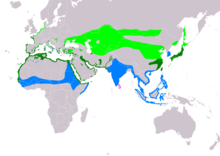
Back Kentse strandkiewiet Afrikaans قطقاط اسكندراني Arabic قطقاط اسكندرانى ARZ Charadrius alexandrinus AST Dəniz çovdarçısı Azerbaijani Зуёк марскі Byelorussian Морски дъждосвирец Bulgarian কেনটিশ প্লোভার Bengali/Bangla Nouelig pikous Breton Corriol camanegre Catalan
| Kentish plover | |
|---|---|

| |
| Male in breeding plumage, India | |
| Scientific classification | |
| Domain: | Eukaryota |
| Kingdom: | Animalia |
| Phylum: | Chordata |
| Class: | Aves |
| Order: | Charadriiformes |
| Family: | Charadriidae |
| Genus: | Anarhynchus |
| Species: | A. alexandrinus
|
| Binomial name | |
| Anarhynchus alexandrinus | |
| Subspecies | |
| |

| |
| Range Breeding Resident Non-breeding Vagrant (seasonality uncertain)
| |
| Synonyms | |
| |
The Kentish plover (Anarhynchus alexandrinus) is a small wader (40–44 g (1.4–1.6 oz)) of the family Charadriidae that breeds on the shores of saline lakes, lagoons, and coasts, populating sand dunes, marshes, semi-arid desert, and tundra.[2][3] Both male and female birds have pale plumages with a white underside, grey/brown back, dark legs and a dark bill; however, additionally the male birds also exhibit very dark incomplete breast bands, and dark markings either side of their head, therefore the Kentish plover is regarded as sexually dimorphic.[4]
The Kentish plover has a large geographical distribution, ranging from latitudes of 10º to 55º, occupying North Africa, both mainland, such as Senegal, and island, such as the Cape Verde archipelago, Central Asia, for example alkaline lakes in China, and Europe, including small populations in Spain and Austria. Some populations are migratory and often winter in Africa, whereas other populations, such as various island populations, do not migrate.[5][6] Its common English name comes from the county of Kent, where it was once found, but it has not bred in Britain since 1979.[7]
Kentish plovers are ground-nesting birds, often with a preference for low, open, moist nesting sites away from thick vegetation and human activity. They use a number of materials to build their nests, mainly consisting of shells, pebbles, grass and leaves in a small scrape in the ground.[8][9] Like most plovers, the Kentish plovers are predominantly insectivores, feeding on a large range of arthropods and invertebrates depending on the environment, by using a run and stop method.[10][11]
- ^ BirdLife International (2019) [amended version of 2016 assessment]. "Charadrius alexandrinus". IUCN Red List of Threatened Species. 2019: e.T22727487A155485165. doi:10.2305/IUCN.UK.2019-3.RLTS.T22727487A155485165.en. Retrieved 2 January 2020.
- ^ Székely, T., A. Argüelles-Ticó, A. Kosztolányi and C. Küpper. 2011. Practical guide for investigating breeding ecology of Kentish plover Charadrius alexandrinus, Unpublished Report, University of Bath
- ^ del Hoyo, J., Collar, N.J., Christie, D.A., Elliott, A. and Fishpool, L.D.C. 2014. HBW and BirdLife International Illustrated Checklist of the Birds of the World, Lynx Edicions BirdLife International, Barcelona, Spain and Cambridge, UK
- ^ Message, S. and Taylor, D.W. 2005. Field guide to the waders of Europe, Asia and North America. London: Christopher Helm Publishers.
- ^ Meininger, P., Székely, T., and Scott, D. 2009. Kentish Plover Charadrius alexandrinus. In: Delaney, S., Scott, D. A., Dodman, T., Stroud, D. A. An atlas of wader populations in Africa and Eurasia. Wetlands International, pp 229-235
- ^ Kosztolányi, A., Javed, S., Küpper, C., Cuthill, I., Al Shamsi, A. and Székely, T. 2009. Breeding ecology of Kentish Plover Charadrius alexandrinus in an extremely hot environment, Bird Study, 56:2, 244-252
- ^ "Focus on: Kentish Plover". BirdGuides. 2020-04-30. Retrieved 2022-01-05.
- ^ AlRashidi, M., Long, P.R., O’Connell, M., Shobrak, M. & Székely, T. 2011. Use of remote sensing to identify suitable breeding habitat for the Kentish plover and estimate population size along the western coast of Saudi Arabia. Wader Study Group Bull. 118(1): 32–39
- ^ Szentirmai, I. and Székely, T. 2002. Do kentish plovers regulate the amount of their nest material? An experimental test, Behaviour, 139(6), pp. 847–859
- ^ Kentish Plover (Charadrius alexandrinus) European birds online guide (no date) Available at: http://www.avibirds.com/html/Kentish_Plover.html (Accessed: 16 January 2017)
- ^ Székely, T., Karsai, I. and Kovazs, S. 1993. Availability of Kentish Plover (Charadrius alexandrinus) prey on a Central Hungarian grassland. Ornis Hung. 3:41-48
